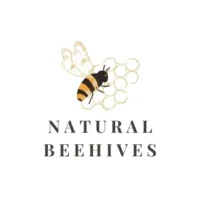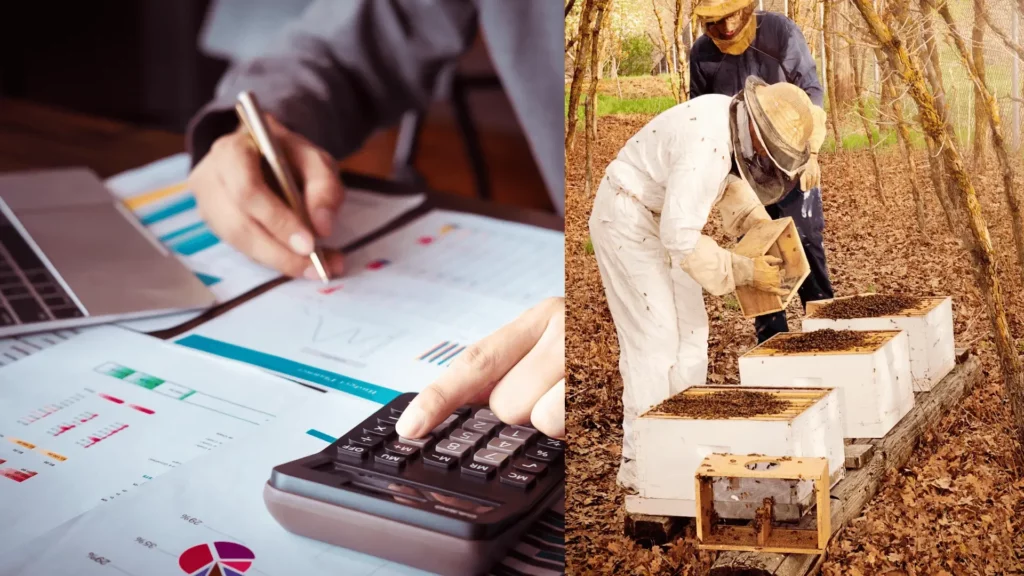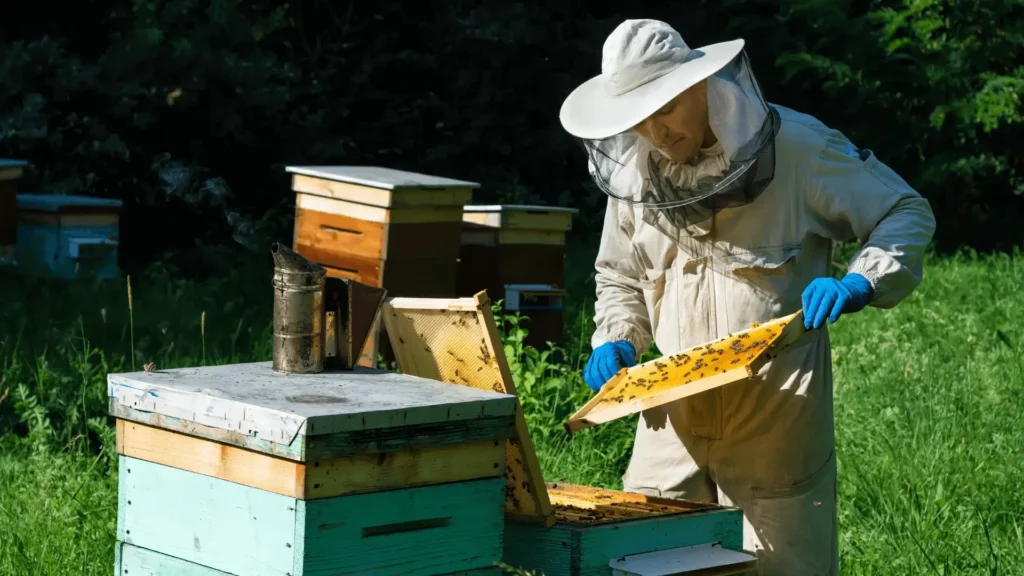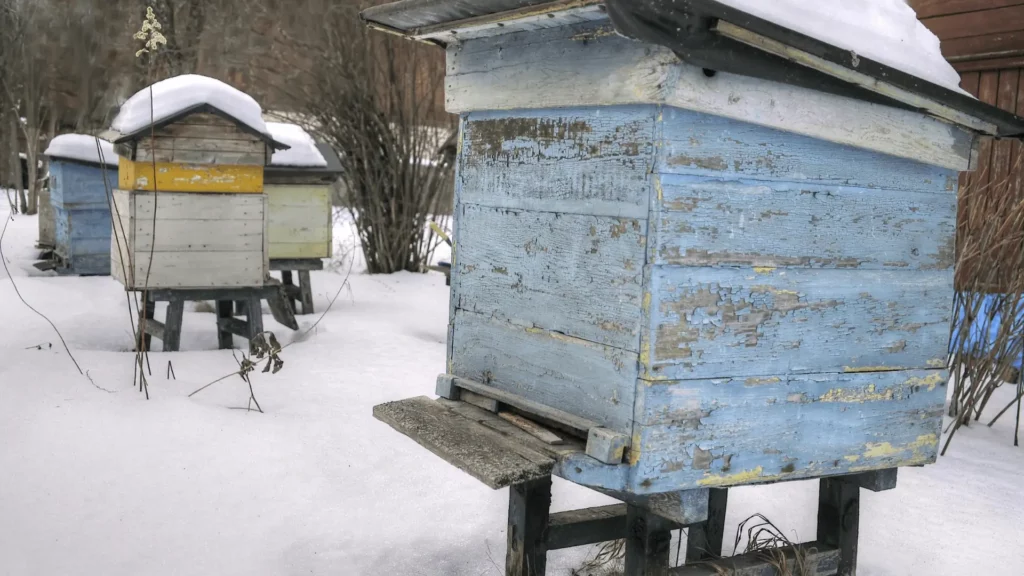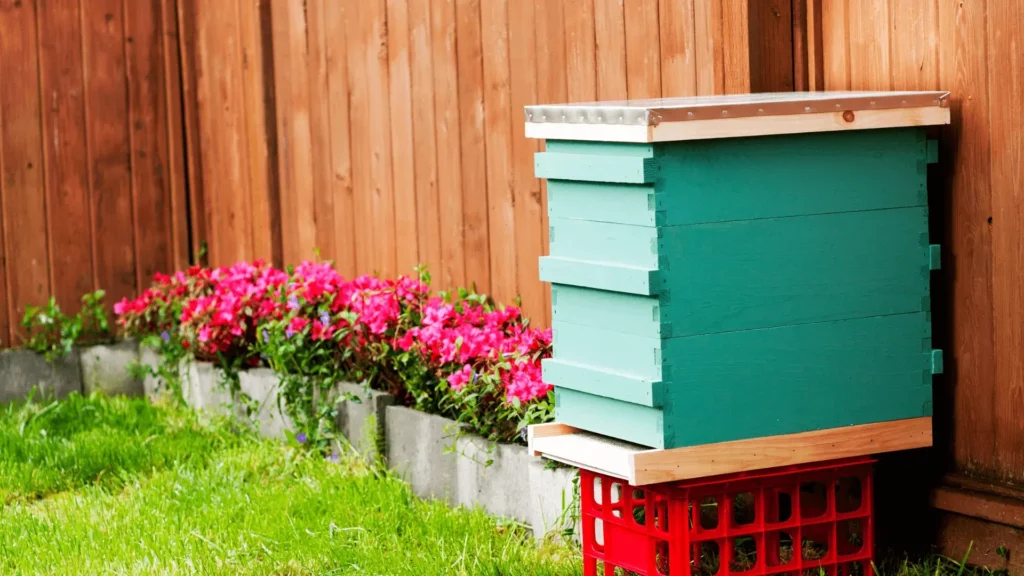
Are you curious about beekeeping? Imagine having your own buzzing colony of honeybees in your backyard, producing golden honey that you can enjoy straight from the hive. Sounds enticing, right?
Beekeeping is not only a fulfilling and rewarding hobby but also plays a vital role in maintaining a healthy honeybee population. Whether you’re a beginner looking to start your beekeeping journey or an experienced beekeeper seeking valuable insights, this ultimate guide is here to help you succeed.
In this comprehensive article, we will delve into the fascinating world of backyard beekeeping. From setting up your bee colony and selecting the right hive type to harvesting your own organic honey, we’ve got you covered. Get ready to explore the ins and outs of beekeeping, discover different hive styles, and learn about the benefits of home-raised honey.
Keep reading as we navigate through the nitty-gritty details of beekeeping, providing you with all the essential information and tips you need to become a successful beekeeper. Let’s embark on this wondrous journey and unlock the secrets of these incredible little critters!
Introduction to Backyard Beekeeping
Backyard beekeeping has gained tremendous popularity in recent years, attracting both beginners and experienced enthusiasts. The rewards of this fascinating hobby extend far beyond the sweet golden honey it produces. By becoming a backyard beekeeper, you’ll actively contribute to the health and preservation of honeybees while reaping the benefits of their hard work.
The increase in awareness about the importance of honeybees’ pollination role has fueled the growing interest in backyard beekeeping. As these incredible creatures flit from flower to flower, they not only collect nectar but also transfer pollen, aiding in the reproduction of various plant species. By introducing a beehive to your backyard, you become a steward of nature, helping to maintain a healthy honeybee population and combating the decline caused by habitat loss and other factors.
Beyond the environmental impact, backyard beekeeping also offers a sense of wonder and discovery. Observing these wondrous little critters at work and witnessing the intricate social structures within their colony can be a truly captivating experience. It’s an opportunity to connect with nature and foster a deeper understanding and appreciation for these amazing insects.
Moreover, backyard beekeeping offers a rewarding harvest – delicious, unpasteurized honey. Unlike the generic grocery store honey, home-raised honey captures the distinct flavors and characteristics of the local floral sources. It’s a true taste of your surroundings and a proud testament to the efforts of your bees.
So, whether you’re intrigued by beekeeping’s promise of organic honey, fascinated by bees as a family member, or simply looking for an interesting hobby, backyard beekeeping is a journey that offers both personal fulfillment and practical rewards. In the upcoming sections of this guide, we will delve deeper into the world of beekeeping and equip you with the knowledge and skills necessary for success.
Is Beekeeping Right for You?
Considering beekeeping as a hobby or potential venture? Before diving into the world of backyard beekeeping, it’s important to assess whether it’s the right fit for you. Here are some key factors to consider:
1. Interest and Passion: Beekeeping requires dedication and a genuine interest in these fascinating creatures. Ask yourself if you have a passion for bees, honey production, and the environment.
2. Time Commitment: Beekeeping demands time and effort. Regular inspections, hive management, and seasonal tasks like honey harvesting require consistent attention. Assess your schedule and availability for this commitment.
3. Allergies and Health Considerations: Bee stings can cause discomfort and allergic reactions. If you have known allergies or sensitivities, consult with a medical professional before embarking on beekeeping.
4. Space and Regulations: Be aware of your local regulations regarding beekeeping in residential areas. Ensure that you have adequate space and meet the necessary requirements.
5. Financial Investment: Starting a beekeeping venture entails some expenses. Consider the costs of acquiring bees, equipment, and protective gear. Plan and budget accordingly.
6. Community and Neighbors: Assess the potential impact beekeeping may have on your neighbors and community. Communication and cooperation are crucial in maintaining positive relationships.
By carefully considering these factors, you can determine whether beekeeping aligns with your interests, lifestyle, and resources. Remember, successful beekeeping requires passion, dedication, and a commitment to the well-being of these wondrous little creatures.
Educate Yourself
To embark on a successful journey in backyard beekeeping, it’s crucial to educate yourself about the ins and outs of this fascinating practice. By enhancing your knowledge and understanding of beekeeping practices, equipment, and basic terminology, you will be well-prepared to care for your bees and ensure their thriving colony.
The Importance of Knowledge and Understanding
1. Become Familiar with Beekeeping Practices:
– Familiarize yourself with the fundamental principles and techniques of beekeeping.
– Learn about hive management, including colony inspection and maintenance.
– Understand the seasonal needs and behavior of bees within your local climate.
2. Get Acquainted with Equipment:
– Explore the various types of beehives available, such as Langstroth hives and top bar hives.
– Understand the purpose and functionality of each hive component, like frames and top covers.
– Learn how to assemble, maintain, and repair your beekeeping equipment.
3. Master Beekeeping Terminology:
– Acquaint yourself with common terms like brood, honey super, queen excluder, and smoker.
– Understand the different roles of bees within the colony, from the queen to the worker bees.
Resources for Learning
1. Books and Online Guides:
– Dive into comprehensive beginner-friendly books on beekeeping, such as “The Beekeeper’s Handbook” by Diana Sammataro and Alphonse Avitabile.
– Explore reputable online platforms dedicated to beekeeping education.
2. Local Beekeeping Associations:
– Connect with experienced beekeepers in your area through local beekeeping associations.
– Attend workshops, seminars, or mentorship programs offered by these associations to enhance your knowledge.
3. University Extension Services:
– Check if your local university offers extension services focusing on beekeeping.
– Utilize their resources, including workshops, consultations, and educational materials.
Remember, knowledge and continuous learning are the pillars of successful beekeeping. By investing time in educating yourself, you will gain the confidence and expertise needed to maintain healthy bee colonies and enjoy the rewards of backyard beekeeping.
Check Your City’s Laws
Before diving into the world of backyard beekeeping, it’s crucial to familiarize yourself with the local laws and regulations governing beekeeping in your city or town. Each area may have its own specific ordinances and guidelines that you need to adhere to in order to keep bees on your property.
Checking your city’s laws ensures that you are in compliance with any restrictions or requirements related to beekeeping in residential areas. There may be rules regarding the maximum number of hives allowed, setback requirements from property lines, or even the need for permits or licenses.
Conduct thorough research and reach out to your local government or agricultural extension office to gather information about the specific regulations in your area. These resources can provide you with valuable insights into any restrictions, guidelines, or best practices that you should be aware of.
By understanding and following your city’s laws, you can ensure a smooth and legal beekeeping experience that aligns with your community’s guidelines. This enables you to enjoy the benefits of backyard beekeeping while maintaining positive relationships with your neighbors and local authorities.
Remember, it’s always better to be well-informed and compliant with the regulations in your area to create a harmonious beekeeping environment for both you and your community.
Consider Your Neighbors
When embarking on your backyard beekeeping journey, it’s crucial to consider the concerns of your neighbors and establish good community relations. Here are a few key points to keep in mind:
Communicate and Educate
Openly communicate with your neighbors about your intention to keep bees and address any concerns they may have. Educating them about the benefits of bees, such as pollination and honey production, can help alleviate worries.
Provide Information
Share information about bee behavior and safety measures to reassure your neighbors. Assure them that honey bees are generally docile and will not pose a threat if left undisturbed. Offer resources or direct them to reliable beekeeping websites where they can learn more.
Set Up Barriers
Consider placing barriers, such as a fence or vegetation, to guide the bees’ flight path away from common gathering areas. This can help minimize encounters and ensure a harmonious coexistence.
Offer Rewards
Consider sharing the rewards of your beekeeping endeavor with your neighbors. Offering them a jar of your delicious, locally produced honey can foster goodwill and showcase the benefits of having bees nearby.
Find Ample Space
Selecting the right location for your beehives is crucial for the success of your backyard beekeeping venture. Here are some guidelines to help you find ample space:
Consider Sunlight
Ensure that the chosen area receives ample sunlight throughout the day. Bees thrive in sunny locations and need the warmth provided by sunlight to maintain optimal hive conditions and productivity.
Proximity to Water
Bees require access to a reliable water source for hydration and hive maintenance. Choose a location near a natural water source, such as a pond or stream, or provide a water feature like a shallow bird bath or a dedicated water station for the bees.
Accessibility
Select a spot that provides easy access for both you and your bees. You’ll need to regularly monitor and inspect the hives, so choose an area where you can easily approach and work around the hives without disturbing your bees or obstructing pathways.
By considering these factors of sunlight, proximity to water, and accessibility, you can find the ideal space to create a conducive environment for your backyard beekeeping endeavor.
Prepare to Spend Some Time and Money
When it comes to backyard beekeeping, it’s important to understand that it requires a significant commitment of both time and financial resources. While the initial investment may seem daunting, the long-term benefits and rewards make it all worthwhile.
Time Commitment
Beekeeping is not a hobby that can be taken lightly. Caring for your bees requires regular attention and diligent work. You’ll need to dedicate time to tasks such as hive inspections, monitoring the health of your colony, and managing any potential issues that may arise. It’s important to consider your availability and schedule before embarking on this journey.
Financial Investment
Beekeeping entails certain costs, including the purchase of equipment and supplies. You’ll need to invest in beehives, frames, protective gear, tools, and other essentials. Additionally, you may need to budget for ongoing expenses such as feeding your bees, replacing worn-out equipment, and seeking professional assistance if necessary.
However, it’s crucial to remember that beekeeping can also bring financial benefits. As your colony thrives and produces honey, you can potentially sell your delicious, home-raised honey. This can help offset some of the initial investment and even turn your beekeeping endeavors into a profitable venture.
How to Build Your Bee Colony
To embark on your backyard beekeeping journey, you’ll need a thriving bee colony. Whether you choose to purchase bees or capture a swarm, establishing a healthy colony is essential. Here are the steps to help you build your bee colony:
1. Purchase Bees: One option is to buy packaged bees, which typically include a queen and a group of worker bees. Make sure to source your bees from trusted suppliers to ensure their health and quality.
2. Capturing a Swarm: Another method is to capture a swarm, which is a group of bees that have left their original hive to find a new home. Swarms can often be found hanging from tree branches or clustered on buildings. By gently scooping the swarm into a suitable hive, you can create a new colony.
3. Select the Right Hive: Before introducing bees to their new home, you’ll need to provide them with a suitable hive. The most common hive type is the Langstroth hive, consisting of multiple stackable boxes with frames where bees build their honeycomb.
4. Prepare the Hive: Ensure your beehive is clean and well-set up before introducing the bees. Check for any damages or cracks, and make sure the frames are in place. Provide a water source near the hive to quench their thirst.
5. Introduce the Bees: Carefully transfer the purchased bees or the swarm into the prepared hive. Follow the instructions provided by the supplier or consult a beekeeping expert for guidance. Be cautious to avoid bee stings by wearing protective gear.
6. Monitor and Feed: Regularly monitor the colony’s progress and provide supplemental feed if necessary, especially during the initial stages when they are establishing their new home. Sugar water mixed in the right ratio can be used as feed.
Remember, building a bee colony requires patience, knowledge, and careful attention. Continuously educate yourself about beekeeping practices, and seek advice from experienced beekeepers or local beekeeping associations for guidance along the way. By following these steps, you can establish a healthy and thriving bee colony in your backyard.
Also read: Buzz with Confidence: The Ultimate Beehive Selection Guide for Novice Beekeepers
Where to Put Your Beehives
When setting up your beekeeping operation, the placement of your beehives plays a crucial role in the success of your colony. Consider these guidelines for hive placement:
Sheltered Location
Choose a location that provides adequate shelter for your beehives. The ideal spot is one that offers protection from harsh weather conditions such as strong winds, excessive sun exposure, and heavy rainfall. A sheltered location helps to mitigate environmental stressors that could impact the health and productivity of your bees.
Wind Protection
Ensure that your beehives are protected from strong gusts of wind. Placing them in an area shielded by hedges, fences, or buildings can provide the necessary windbreak. This will help maintain the stability of the hives and prevent any disturbance to the bees inside.
Entrance Direction
Consider the entrance direction of the beehives. Ideally, the entrance should face southeast or east, allowing the bees to receive the morning sunlight. This orientation helps to warm up the hive early in the day, enabling the bees to start their activities promptly.
Accessibility
Ensure easy access to your beehives for maintenance and inspections. Plan for enough space around the hives to comfortably maneuver and work without disturbing the colony. This accessibility will make regular hive checks, feeding, and honey harvesting more efficient.
Remember, the location of your beehives directly impacts the overall health and productivity of your colony. By following these guidelines, you can provide a suitable habitat for your bees and set them up for success in your backyard beekeeping venture.
Essential Beekeeping Equipment and Supplies
When venturing into the world of backyard beekeeping, having the right equipment and supplies is crucial for the success of your endeavor. As a beginner, it’s essential to invest in the following items to ensure a strong foundation for your beekeeping journey:
Beehives and Frames
Beehives serve as the home for your bees, providing them with the necessary space to build their honeycomb and raise their brood. The most commonly used hive type is the Langstroth hive, consisting of multiple stackable boxes known as supers. These supers contain frames, which hold the beeswax foundation where bees construct their honeycomb. As a general rule of thumb, starting with two supers is recommended.
Protective Gear
Ensuring your safety is paramount when working with bees. A bee suit or jacket, gloves, and a veil are essential items to protect yourself from bee stings. Opt for high-quality protective gear that offers full coverage to shield your body from potential stings.
Tools
Having the right tools will make your beekeeping tasks much easier. Some necessary tools include a hive tool for prying apart frames and supers, a bee brush for gently moving bees, and a smoker to calm the bees during inspections. These tools will help you navigate through the beehive and handle your bees with care.
Feeder
A feeder is crucial, especially when starting a new colony or during times when nectar flow is limited. It provides supplemental food for your bees, ensuring they have enough resources to thrive. Choose a feeder that suits your hive type, such as an entrance feeder or a top feeder.
Remember, investing in high-quality equipment and supplies will go a long way in supporting the health and productivity of your honeybee population. Prioritize durability and functionality when selecting your beekeeping essentials.
Also read: Beekeepers Toolbox Essentials: Practical Must-Haves for Successful Beekeeping
Must-Have Protective Gear
When it comes to beekeeping, ensuring your safety is paramount. Bee stings can be quite painful and can even cause allergic reactions in some individuals. That’s why it’s crucial to have the right protective gear. Here are the essential items you’ll need:
1. Bee Suit: A bee suit is a full-body protective garment that includes a zippered hood and veil. It provides excellent coverage and prevents bees from coming into direct contact with your skin.
2. Gloves: Choose gloves made of durable material that extends up to your forearms. They protect your hands and arms from stings while maintaining dexterity.
3. Veil: A veil is a mesh netting that attaches to your bee suit or hat, ensuring bees cannot access your face. Opt for a veil that securely attaches to your suit and provides clear visibility.
Remember, bees are intelligent creatures that can find their way into small openings, so it’s crucial to select well-fitting gear without any holes or gaps.
Also read: The Ultimate Beekeeping Starter Kit: Everything You Need to Get Started
How to Choose Your Bees
When it comes to starting your backyard beekeeping journey, choosing the right bees is crucial for the success of your colony. There are several options available for acquiring bees, each with its own advantages and considerations. Here are the three primary methods:
Buying Packaged Bees
One option is to purchase packaged bees, which typically consist of a queen bee and a certain number of worker bees. These bees are often sold in screened boxes along with a can of syrup to sustain them during transport. Buying packaged bees allows you to start with a pre-established colony and ensures a stable population size from the beginning.
Capturing Swarms
Another way to acquire bees is by capturing swarms. Swarming is a natural process in which a queen bee and a large number of worker bees leave their original colony to establish a new one. Swarms can be found hanging from tree branches, fence posts, or other outdoor structures. By capturing a swarm, you can obtain a healthy and genetically diverse group of bees without purchasing them.
Sourcing from Local Beekeepers
Lastly, you can source bees from local beekeepers in your area. This option allows you to acquire bees that are already adapted to your specific climate and environment. Local beekeepers can provide you with nucleus colonies, also known as “nucs,” which usually consist of a small number of bees, brood frames, and a queen bee. Buying bees from local beekeepers supports the preservation of healthy honeybee populations and can provide valuable guidance and mentorship throughout your beekeeping journey.
Regardless of the method you choose, it’s essential to ensure that the bees you acquire are healthy and free from diseases or pests such as Varroa mites. It’s also recommended to consult with local beekeeping associations or university extension services for guidance on reputable sources and best practices for acquiring bees.
Remember, starting with a strong and healthy bee colony is a crucial step towards successful backyard beekeeping. By carefully considering the options and making an informed decision about acquiring your bees, you’ll be on your way to establishing a thriving hive and enjoying the rewards of beekeeping.
Also read: Unraveling the Secrets of Medieval Beekeeping
Harvesting and Using Honey
Harvesting honey is one of the most exciting and rewarding aspects of backyard beekeeping. It allows you to enjoy the fruits of your bees’ labor and indulge in the golden sweetness of your very own honey. Here’s a step-by-step guide to help you harvest and utilize your honey effectively.
Harvesting Process
1. Timing: Harvesting honey requires careful timing. As a general rule of thumb, honey can be harvested when the honeycombs are around 80% capped. This ensures that the honey has reached an appropriate moisture content for long-term storage.
2. Preparing the Bees: Before you begin, it’s important to reassure the bees by using a bee brush or a gentle puff of smoke to encourage them to move away from the frames you’ll be harvesting.
3. Removing Frames: Carefully remove the frames filled with capped honey from the hive. Use a bee brush to remove any remaining bees.
4. Extraction: To extract the honey from the frames, you have a few options:
– Using a honey extractor: This is a device that spins the frames, allowing the honey to be extracted using centrifugal force.
– Crushing and straining: You can crush the honeycomb and strain it through a fine mesh to separate the honey from the wax.
5. Filtering: Once the honey is extracted, strain it through a fine mesh or cheesecloth to remove any impurities or wax particles. This will result in clear, pure honey.
6. Storing Honey: Transfer the filtered honey into clean, sterilized jars or containers. Ensure they are sealed tightly to prevent any moisture or air from entering.
Using Honey
Now that you have harvested your honey, here are some creative and practical ways to use it:
1. In Cooking and Baking: Sweeten your favorite recipes by substituting sugar with honey. It adds a unique flavor and boosts the nutritional value of your dishes.
2. For Natural Remedies: Honey has antibacterial and healing properties, making it a great addition to homemade remedies for soothing sore throats, calming coughs, or treating minor burns and cuts.
3. In Skincare: Honey is known for its moisturizing and anti-inflammatory properties. Use it as a natural face mask, lip balm, or hair conditioner for a healthy and glowing complexion.
4. As a Natural Sweetener: Drizzle honey over yogurt, pancakes, or oatmeal for a natural and nutritious sweetener. It’s a healthier alternative to processed sugars.
Remember, as a beekeeper, it’s essential to prioritize the health and well-being of your honeybees. Avoid harvesting excessive amounts of honey, ensuring they have enough to sustain themselves through the seasons. Enjoy the wonderful flavors and uses of your home-raised honey while supporting the health of these wondrous little creatures.
Also read: Mastering Indoor Beekeeping: Benefits, Techniques, and Tips
Benefits of Organic Honey
When it comes to honey, organic is the way to go. Here are some compelling reasons why you should consider producing and consuming organic honey:
1. Quality: Organic honey is produced by bees that forage on flowers and plants free from pesticides, chemicals, and genetically modified organisms (GMOs). This ensures a high-quality product that is free from any harmful contaminants.
2. Taste: Organic honey has a distinct flavor profile that is often described as more robust, flavorful, and complex compared to conventional honey. Each jar of organic honey carries the unique essence of the diverse nectar sources the bees have visited.
3. Health Benefits: Organic honey retains all the natural enzymes, vitamins, and minerals that benefit our health. It is rich in antioxidants, which help protect the body against free radicals, boost the immune system, and promote overall well-being.
4. Environmental Impact: Choosing organic honey supports sustainable beekeeping practices and contributes to the preservation of honeybee populations. Organic farming methods promote biodiversity and the health of pollinators, ensuring a healthier ecosystem.
5. Supporting Local Beekeepers: By purchasing organic honey from local beekeepers, you are directly supporting small-scale beekeepers who are passionate about their craft and dedicated to the welfare of their bees.
So, when selecting honey for your pantry, opt for organic honey and savor its exceptional quality, delightful taste, and numerous health benefits.
